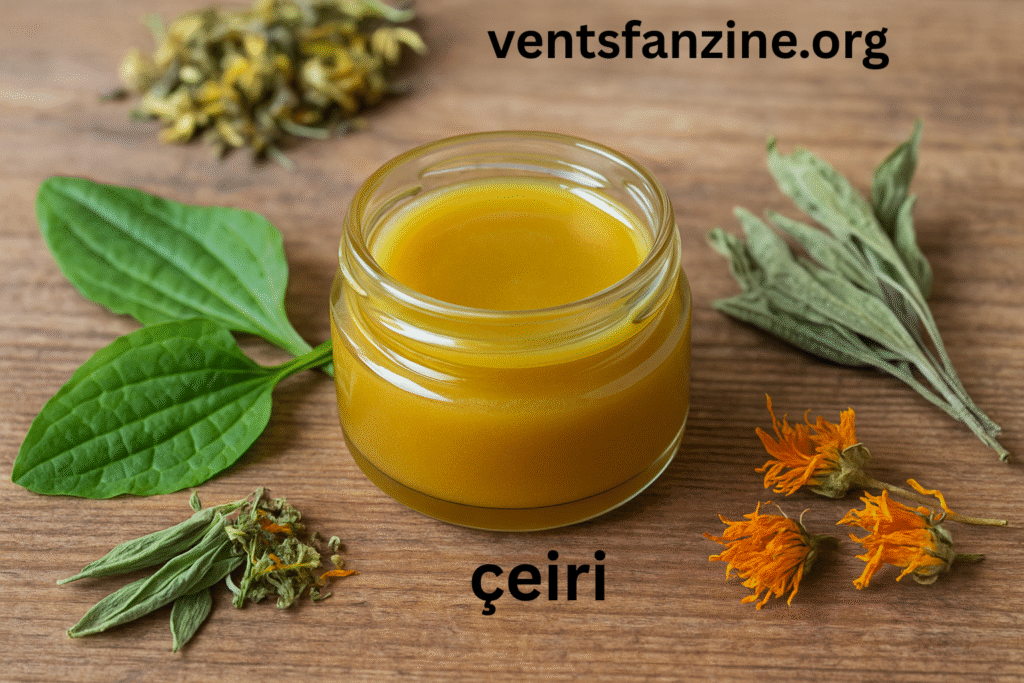
Introduction to Çeiri
In the world of traditional remedies and ancient culinary elements, few items hold the quiet yet resilient presence of çeiri. This versatile, naturally derived substance—rooted in herbal practices and culinary traditions—has been part of folk knowledge for generations. Whether used as a topical preparation, a cooking enhancement, or a base for infusions, çeiri offers more than nostalgia. It continues to find relevance in a health-conscious and culturally curious world.
But what exactly is çeiri?
At its core, çeiri is a plant-based resin or paste—depending on the region and processing method—often extracted from medicinal herbs or wild shrubs native to parts of the Mediterranean and Middle East. Though not commonly found in mainstream pharmacies or supermarkets, çeiri remains a go-to element in local households, especially in rural and mountainous areas where ancestral practices thrive.
In this blog post, we explore the layers of çeiri’s story—from its history to health effects, and from preparation to modern-day innovation.
Historical Significance of Çeiri
The use of çeiri can be traced back centuries, with roots embedded in traditional medicine systems across the Balkans, Anatolia, and parts of Persia. Local healers and herbalists would prepare çeiri from scratch, using seasonal gatherings of specific leaves, flowers, or bark, slow-simmered in oil or vinegar until thick and aromatic. This substance was believed to carry the therapeutic essence of nature—harnessing everything from anti-inflammatory properties to spiritual cleansing.
Old manuscripts and oral traditions refer to çeiri as a “village balm” or “healing sap.” During times when access to professional medical care was limited, çeiri stood as a frontline defense against colds, skin infections, and digestive problems. Some communities even used it during spiritual ceremonies, believing it had protective powers.
Interestingly, çeiri also served as an emblem of domestic wisdom—passed down from grandmothers to younger generations through seasonal rituals and collective preparation. It wasn’t just a remedy; it was a legacy.
Conventional Applications of Çeiri
Traditional applications of çeiri fall into three broad categories:
1. Topical Treatments
One of the most common uses of çeiri is in external applications. When applied to the skin, the warm paste acts as a soothing agent for:
- Minor burns and wounds
- Insect bites
- Muscle cramps
- Dry or cracked skin
Its composition—typically infused with herbal oils and waxes—creates a barrier that helps retain moisture while delivering plant-based compounds directly into the skin.
2. Digestive Aid
In some traditions, çeiri is ingested in small quantities, either dissolved in warm water or blended with honey. It’s said to soothe the gut, stimulate bile production, and support liver detox. Folk practitioners often recommend it during bouts of indigestion or after a heavy meal.
3. Aromatherapy and Relaxation
When çeiri is prepared with specific herbs like lavender or sage, it becomes an aromatic agent for relaxation. Some households burn it gently like incense to calm nerves and cleanse the indoor environment.
These practices highlight çeiri’s role not only as a remedy but as part of the everyday rhythm of life—blending healing, ritual, and maintenance.
Healthy Point Advantage of Çeiri
Scientific studies on çeiri remain limited, mainly due to its regional specificity and variability in formulation. However, its ingredients often overlap with known medicinal herbs, which allows for a grounded discussion of its potential health advantages.
1. Anti-Inflammatory Properties
Çeiri formulations often include plants like Hypericum perforatum (St. John’s Wort), Salvia officinalis (sage), or Plantago major (plantain)—all recognized for anti-inflammatory effects. These can help reduce swelling and redness in skin and joints when used externally.
2. Antibacterial and Antifungal Qualities
Due to the inclusion of natural oils and occasionally vinegar, çeiri may create an environment that’s unfavorable to bacteria and fungi. It’s often used on minor cuts to prevent infections.
3. Digestive Benefits
The bitters used in some çeiri variants (e.g., from wild herbs or barks) are known to stimulate digestion, ease bloating, and support liver function.
4. Stress Reduction and Sleep Support
When made with calming herbs like chamomile, çeiri can contribute to better relaxation. Some users dab a small amount on the temples or chest before sleep.
These benefits make çeiri a multifaceted tool—especially in communities that prioritize natural wellness and preventive care.
Instructions for the Preparation and Use of Çeiri
Making çeiri at home requires patience and access to quality herbs, but it’s not overly complicated. Below is a traditional approach used by many across rural Anatolia and the Balkans.
Basic Ingredients:
- 1 cup olive oil (or almond oil)
- 2 tablespoons beeswax
- 2 tablespoons of dried herbs (plantain, sage, calendula, or any local medicinal mix)
- Optional: Add a few drops of essential oil like lavender or peppermint for enhanced aroma and added therapeutic value.
- A clean jar for storage
Steps:
- Herbal Infusion: Heat the olive oil on low and add the herbs. Let it simmer for about 45–60 minutes. The key is gentle heat to avoid burning.
- Strain: Once the herbs have released their essence into the oil, strain them out using a cheesecloth.
- Wax Binding: Add the beeswax to the strained oil and gently melt it. Stir until fully blended.
- Cool and Store: Pour the hot mixture into a clean glass jar and allow it to cool. Store it in a dark, cool place.
Usage Tips:
- Apply a fingertip-sized amount on the affected area for skin issues.
- For digestive use, only consume çeiri if you’re certain of its ingredients and have consulted a qualified herbalist.
- Use within 6–12 months for best potency.
Contemporary Applications and Adaptations of Çeiri
In recent years, there’s been a quiet revival of interest in çeiri among urban wellness seekers, DIY naturalists, and alternative medicine practitioners. Here’s how çeiri is being adapted today:
1. Natural Skincare Products
Boutique brands and Etsy sellers now offer çeiri-infused balms, lip salves, and moisturizers. These often blend traditional recipes with modern packaging and quality control.
2. Massage and Aromatherapy
Modern spas and holistic therapy centers sometimes use çeiri as a massage aid, particularly for muscular relaxation and energy balancing.
3. Home Remedies Market
Çeiri is increasingly shared through blogs, YouTube channels, and social media reels—often repackaged with modern wellness language like “organic herbal salve” or “ancestral resin.”
4. Workshops and Cultural Heritage Events
Communities are holding workshops on çeiri-making, both as a means of education and cultural preservation. These events emphasize sustainability, plant knowledge, and intergenerational learning.
Possible Dangers and Adverse Reactions Associated with the Use of Çeiri
Despite its many positives, çeiri is not without risks—especially when prepared or used improperly.
Allergic Reactions
Certain herbs used in çeiri (e.g., arnica, wild rue, or comfrey) can cause allergic reactions in sensitive individuals. Always patch-test before wider application.
Toxic Ingredients
Some traditional recipes include plants that are mildly toxic if ingested in large quantities. This is why internally consuming çeiri should be done with expert guidance.
Contamination Risks
Improper preparation or storage can lead to mold growth or rancid oils. Always use sterile containers and store in cool, dry places.
Interaction with Medications
If you’re on blood thinners, antidepressants, or antibiotics, certain herbal ingredients may interfere with your prescription. Again, a consultation with a healthcare provider is wise.
Where to Locate and Acquire Genuine Çeiris?
As çeiri isn’t typically stocked on mainstream shelves, finding authentic versions requires some direction:
1. Local Herbalists or Markets
In regions where çeiri is culturally significant, you’ll often find it sold in open markets, typically in small glass jars or paper wraps.
2. Specialty Stores
Some Middle Eastern or Mediterranean grocers may carry çeiri or its close equivalents.
3. Online Platforms
Websites like Etsy, small apothecaries, or natural wellness shops occasionally list çeiri balms under various names. Look for sellers with transparent sourcing and ingredients.
4. DIY Workshops or Community Co-ops
Attending a local herbal medicine workshop or joining a wellness cooperative can give you access to both the product and the know-how behind it.
Concluding Point on Çeiri
Çeiri isn’t just an old-world curiosity—it’s a living tradition that continues to evolve. Whether used for skin care, digestive support, or simple spiritual grounding, it reflects a philosophy of self-care that values nature, patience, and ancestral knowledge.
In an age dominated by lab-made solutions and fast results, çeiri reminds us of the quiet effectiveness of slow-made remedies. Its history teaches respect for tradition. Its benefits offer practical relief. And its future depends on how well we preserve and adapt this cultural gem for the next generation




